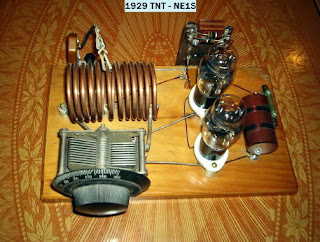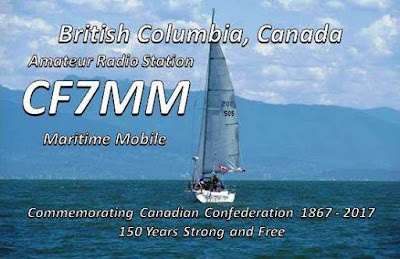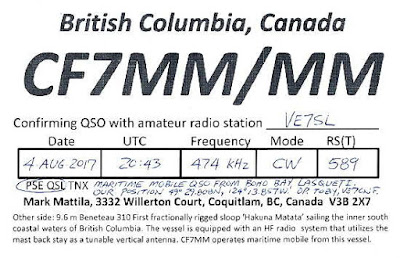Author Archive
 Building For The BK Party?
Building For The BK Party?

It's almost that time of the year when, once again, the '29ers start preparing for the winter Bruce Kelley 1929 CW Party. A recent posting on the Yahoo AWA (Builder's) Group by Lou, VE3AWA, reminded everyone that there were only 108 more sleeps before this year's Party.
In case you're not familiar with the 'BK', it's a winter CW event celebrating the early days of amateur radio.
Transmitters used for the event must be self-excited only ... no crystals are allowed ... and the tube(s) used must be those that were available in 1929 or earlier. It's an eye-opener to hear how the band must have sounded in the early days of amateur radio CW... even better if you're making those beautiful sounds yourself.
The 'BK' usually spawns a flurry of construction, so if you think it is something that might interest you, you have until December to get ready! Unfortunately many aspiring '29ers always leave it too late and inevitably run out of time before any last glitches can be overcome.
For many builders of '29-style gear, especially transmitters, the two-weekend December event is the highlight of the year as it gives them the opportunity to get on the air with their early-style rigs and work as many other '29ers as they can.
Every year there are numerous transcontinental CW contacts made with the simple, usually single-tube, self-excited oscillators that look as if they would have difficulty just being heard across town! Tuning in to the BK Party may be the closest thing you can find to a 'time machine' these days, as a small section of the CW bands (160-40m) take on the same sounds you would have heard when tuning across these bands in the late '20s.
When I first listened to a BK Party several years ago, I was surprised at the wide range of signal quality coming from these faithfully reproduced exhalers, running the gamut from the 'almost Collins-like' MOPAs to the unique sounding raw-AC notes coming from some of the one-lungers.
Most of the stations I have worked in past BK events were running less than 10W input yet, even with the terrible conditions experienced in the last two events, their signals were making it across the continent on the low bands ... and all were having a great time doing it!
Larry's (NE1S) TNT makes it back to the west coast every year in the BK Party.
Shown above is a fine little TNT built by Kevin, WB2QMY, in New York. It uses a very affordable UX-201A triode, originally manufactured in 1925 for radio receivers. Although Kevin's TNT puts out barely 2 watts on 80m CW, we had no trouble working each other in the BK QSO Party. If you build it, they will come!
If you've ever entertained thoughts of wanting to participate in the '29 QSO Party, this late-summer 'heads-up', could be just what you need to make it happen ... there is still plenty of time to put something together for this year's event. Here is the specific information for this year's BK Party.
There is plenty of information available right here on my blog that will answer many of your initial concerns surrounding tubes, circuits and components:
An Introduction To Building ... '29-Style
'29-Style Transmitters ... What To Build? - Part 1
'29-Style Transmitters ... What To Build? - Part 2
As well, my own website contains several detailed construction procedures on various transmitter styles used back in the day ... and an inspirational 'Gallery of '29-Style Transmitters' from other builders. In addition, there is a lot more '29-specific information in this blog, all of which can be found here, for several nights of bedtime reading!
Should you decide to take on a simple transmitter for this year's party (and there are dozens of participants hoping that you will), here are a few things to keep in mind:
You don't need much power to make contacts ... just a few watts will do it. If your antenna system is efficient and you can hear reasonably well, expect to work '29ers all across the continent.
Your transmitter does not have to 'look pretty'! You can breadboard up something with modern components and as long as the tube-year qualifies, you're good to go. Too many get bogged-down with making a showpiece ... that can always come later.
I, and others, have found Hartley oscillators to be the easiest to get going and often produce the best notes. Although the power limit this year has been increased to 25 watts DC input, just 2 or 3 watts coming from a simple Hartley will guarantee you a ticket on the BK time machine.
A wonderful source of advice, inspiration and even help with parts, can be had by joining the AWA (Builders) Group.
For now, I'll tempt you with the basic information regarding the QSO Party as published by the 'BK' sponsor...the AWA.
The Bruce Kelly 1929 QSO Party is a yearly AWA sponsored event where participants build their own transmitters using the designs, techniques, and tubes that were available in 1929 and earlier, and then put those classic transmitters on the air and try to contact as many other 1929 stations as possible. Since they use early designs, it is a cacophony of whooping, chirping, buzzing, clicking, drifting, swishing, swaying, warbling, and other interesting signals. This is what ham radio sounded like in 1929 and for two weekends in December its 1929 again on the ham bands.
Rules: Transmitters must be 1929 or earlier types of self oscillators such as the Hartley, TNT, PP tuned grid tuned plate, MOPA, Colpitts, etc. No crystal oscillators. Tubes must have been available during or before 1929. Typical tubes often used are type 10, 45, 27, 211, 71A. Individual stations can be worked only once on each band over the course of two weekends. You can use any vintage or modern receiver that you wish. The event is open to all 1929 stations including non-AWA members and AWA members.
Input Power: Transmitters are limited to a power INPUT of 25 watts or less.
Frequencies: The QSO Party typically operates between 1800 to 1810 Kcs, 3550 to 3580 Kcs , 7100 to 7125 Kcs, plus or minus depending on QRM. 40 meter activity is up significantly because it offers both night time AND daytime propagation!
Presently, a large percentage of the activity is from Minnesota and points eastward ... the west is poorly represented for some reason but activity out this way has been slowly increasing over the past few years.
You don't need much in the way of power ... every year I work several eastern 'BK' stations that are running just 2 or 3 watts, usually using receiver tubes pressed into RF oscillator service ... much like the original 'boys of '29' probably had to do.
With the solar cycle winding-down and the expected return of undisturbed great winter conditions, this year's BK Party should be better than ever ... especially with even more new clunkers chirping away in the night.
Should you join the fun, there will be many '29ers looking for you I can guarantee!
 |
| courtesy:VE3AWA |
 Building For The BK Party?
Building For The BK Party?

It's almost that time of the year when, once again, the '29ers start preparing for the winter Bruce Kelley 1929 CW Party. A recent posting on the Yahoo AWA (Builder's) Group by Lou, VE3AWA, reminded everyone that there were only 108 more sleeps before this year's Party.
In case you're not familiar with the 'BK', it's a winter CW event celebrating the early days of amateur radio.
Transmitters used for the event must be self-excited only ... no crystals are allowed ... and the tube(s) used must be those that were available in 1929 or earlier. It's an eye-opener to hear how the band must have sounded in the early days of amateur radio CW... even better if you're making those beautiful sounds yourself.
The 'BK' usually spawns a flurry of construction, so if you think it is something that might interest you, you have until December to get ready! Unfortunately many aspiring '29ers always leave it too late and inevitably run out of time before any last glitches can be overcome.
For many builders of '29-style gear, especially transmitters, the two-weekend December event is the highlight of the year as it gives them the opportunity to get on the air with their early-style rigs and work as many other '29ers as they can.
Every year there are numerous transcontinental CW contacts made with the simple, usually single-tube, self-excited oscillators that look as if they would have difficulty just being heard across town! Tuning in to the BK Party may be the closest thing you can find to a 'time machine' these days, as a small section of the CW bands (160-40m) take on the same sounds you would have heard when tuning across these bands in the late '20s.
When I first listened to a BK Party several years ago, I was surprised at the wide range of signal quality coming from these faithfully reproduced exhalers, running the gamut from the 'almost Collins-like' MOPAs to the unique sounding raw-AC notes coming from some of the one-lungers.
Most of the stations I have worked in past BK events were running less than 10W input yet, even with the terrible conditions experienced in the last two events, their signals were making it across the continent on the low bands ... and all were having a great time doing it!
Larry's (NE1S) TNT makes it back to the west coast every year in the BK Party.
Shown above is a fine little TNT built by Kevin, WB2QMY, in New York. It uses a very affordable UX-201A triode, originally manufactured in 1925 for radio receivers. Although Kevin's TNT puts out barely 2 watts on 80m CW, we had no trouble working each other in the BK QSO Party. If you build it, they will come!
If you've ever entertained thoughts of wanting to participate in the '29 QSO Party, this late-summer 'heads-up', could be just what you need to make it happen ... there is still plenty of time to put something together for this year's event. Here is the specific information for this year's BK Party.
There is plenty of information available right here on my blog that will answer many of your initial concerns surrounding tubes, circuits and components:
An Introduction To Building ... '29-Style
'29-Style Transmitters ... What To Build? - Part 1
'29-Style Transmitters ... What To Build? - Part 2
As well, my own website contains several detailed construction procedures on various transmitter styles used back in the day ... and an inspirational 'Gallery of '29-Style Transmitters' from other builders. In addition, there is a lot more '29-specific information in this blog, all of which can be found here, for several nights of bedtime reading!
Should you decide to take on a simple transmitter for this year's party (and there are dozens of participants hoping that you will), here are a few things to keep in mind:
You don't need much power to make contacts ... just a few watts will do it. If your antenna system is efficient and you can hear reasonably well, expect to work '29ers all across the continent.
Your transmitter does not have to 'look pretty'! You can breadboard up something with modern components and as long as the tube-year qualifies, you're good to go. Too many get bogged-down with making a showpiece ... that can always come later.
I, and others, have found Hartley oscillators to be the easiest to get going and often produce the best notes. Although the power limit this year has been increased to 25 watts DC input, just 2 or 3 watts coming from a simple Hartley will guarantee you a ticket on the BK time machine.
A wonderful source of advice, inspiration and even help with parts, can be had by joining the AWA (Builders) Group.
For now, I'll tempt you with the basic information regarding the QSO Party as published by the 'BK' sponsor...the AWA.
The Bruce Kelly 1929 QSO Party is a yearly AWA sponsored event where participants build their own transmitters using the designs, techniques, and tubes that were available in 1929 and earlier, and then put those classic transmitters on the air and try to contact as many other 1929 stations as possible. Since they use early designs, it is a cacophony of whooping, chirping, buzzing, clicking, drifting, swishing, swaying, warbling, and other interesting signals. This is what ham radio sounded like in 1929 and for two weekends in December its 1929 again on the ham bands.
Rules: Transmitters must be 1929 or earlier types of self oscillators such as the Hartley, TNT, PP tuned grid tuned plate, MOPA, Colpitts, etc. No crystal oscillators. Tubes must have been available during or before 1929. Typical tubes often used are type 10, 45, 27, 211, 71A. Individual stations can be worked only once on each band over the course of two weekends. You can use any vintage or modern receiver that you wish. The event is open to all 1929 stations including non-AWA members and AWA members.
Input Power: Transmitters are limited to a power INPUT of 25 watts or less.
Frequencies: The QSO Party typically operates between 1800 to 1810 Kcs, 3550 to 3580 Kcs , 7100 to 7125 Kcs, plus or minus depending on QRM. 40 meter activity is up significantly because it offers both night time AND daytime propagation!
Presently, a large percentage of the activity is from Minnesota and points eastward ... the west is poorly represented for some reason but activity out this way has been slowly increasing over the past few years.
You don't need much in the way of power ... every year I work several eastern 'BK' stations that are running just 2 or 3 watts, usually using receiver tubes pressed into RF oscillator service ... much like the original 'boys of '29' probably had to do.
With the solar cycle winding-down and the expected return of undisturbed great winter conditions, this year's BK Party should be better than ever ... especially with even more new clunkers chirping away in the night.
Should you join the fun, there will be many '29ers looking for you I can guarantee!
 |
| courtesy:VE3AWA |
 Hunting For NDBs In CLE 222
Hunting For NDBs In CLE 222
 |
| HM - 221 kHz Hamilton, Ontario |
This coming weekend will see another CLE challenge. This time the hunting grounds will be all inclusive: 190-1740 kHz. As well, there are two options, HOME and DX as explained below.
For those unfamiliar with this monthly activity, a 'CLE' is a 'Co-ordinated Listening Event', as NDB DXers around the world focus their listening time (usually) on one small slice of the NDB spectrum.
Summertime CLEs can often be challenging, not because of poor propagation but more likely, summer lightning storms ... hopefully it will be quiet for your location.
When tuning for NDBs, put your receiver in the CW mode and listen for the NDB's CW identifier, repeated every few seconds. Listen for U.S. NDB identifiers approximately 1 kHz higher or lower than the published transmitted frequency since these beacons are modulated with a 1020 Hz tone approximately.
For example, 'AA' (Fargo - ND) transmits on 365 kHz and its upper sideband CW identifier is tuned at 366.025 kHz while its lower sideband CW ident can be tuned at 363.946 kHz. Its USB tone is actually 1025 Hz while its LSB tone is 1054 Hz.
Often, one sideband will be much stronger than the other so if you don't hear the first one, try listening on the other sideband.
Canadian NDBs normally have an USB tone only, usually very close to 400 Hz. They also have a long dash (keydown) following the CW identifier.
All NDBs heard in North America will be listed in the RNA database (updated daily) while those heard in Europe may be found in the REU database. Beacons heard outside of these regions will be found in the RWW database.
From CLE organizer Brian Keyte, G3SIA, comes the usual 'heads-up':
Hi all
Our 222nd Co-ordinated Listening Event, 'DX and HOME', starts on Friday
and runs for an extra day. First-time CLE logs will also be very welcome
of course.
Days: Friday 25th August - TUESDAY 29th August
Times: Midday on Friday to Midday on Tuesday, your LOCAL time
QRG: Normal LF/MF frequencies (190 - 1740 kHz)
NDBs: Normal DX and 'HOME' ones (not DGPS, Navtex or Amateur)
There are two parts (you can listen for either or both of them):
DX:
Please try to log NDBs that are over 2,000 km / 1,250 miles from you.
(If you don't have details of the distances of NDBs from you, please see
the end of this email)
HOME:
If you have any, please log the NDBs in YOUR OWN radio country.
For listeners in AUS, CAN and USA, that means your State or Province.
Our full list of radio countries can be found at:
http://www.ndblist.info/ndbinfo/countrylist.pdf
(If you also mention any of your home regulars NOT heard, it will help
others to know about NDBs, maybe DX to them, that may not be active)
Please post your CLE log to the List in a plain text email if possible,
with 'CLE222' at the start of its title and showing on each log line:
The full Date ( e.g. 2017-08-25 or just the day number 25 )
UTC (the day changes at 00:00 UTC).
kHz - the nominal published frequency
The Call Ident.
Please put those four main log items FIRST, with any other optional
details such as location and distance LATER in the same line.
Your log will be more interesting if you keep the two parts, DX and HOME,
separate in it. Any UNIDs that you come across will also be of interest -
in a separate, third, part of your log please.
If you send interim logs, please make sure that you also send a 'Final' log
showing ALL your loggings for the CLE.
I will send the usual 'Any More Logs?' email at about 17:00 UTC on
WEDNESDAY so you can check that your log has been found OK.
Do make sure that your Final log has arrived on the list by 08:00 UTC
on Friday 1st September at the very latest.
Joachim hopes to complete the combined results on the Saturday.
Good listening
Brian
----------------------------------------------------------
From: Brian Keyte G3SIA ndbcle'at'gmail.com
Location: Surrey, SE England (CLE coordinator)
----------------------------------------------------------
(If you wish you could use a remote receiver for your loggings,
stating its location and owner - with permission if required.
A remote listener may NOT also use another receiver, whether
local or remote, to obtain further loggings for the same CLE.
The HOME radio country and the distances would be based on
where the receiving equipment is located)
DISTANCES TO NDBs FROM YOUR LOCATION
The Great Circle program GcmWin by SM3GSJ can produce a nice great circle
map centred on your location - see http://www.qsl.net/sm3gsj/
Users of Michael's NDB Handbooks will already have their distances and
bearings to the NDBs.
Alex's WWSU program has a facility to create a map showing the areas
inside the 2000 km circle.
To create this,
click on 'Tools'
click on 'Station Radar'
select Range from “2000” to “10000” km
select “show NDB stations”
click on “Generate Image”
click on “Save To File”
That will create a text-file containing information on the selected NDBs.
The REU/RNA/RWW Database provides a powerful way of finding which
NDBs to search for:
1) Go to the signals screen using -
http://www.classaxe.com/dx/ndb/reu?mode=signals
If you are in North America, replace the reu above with rna
If you are not in Europe or North America, replace the reu with rww
2) On the Range line, put your *Locator in the 'From GSQ' box (e.g. mine
is IO91tg) The DX fields become enabled when a GSQ is entered.
3) Enter 2000 in the first DX field, leave the second blank and leave the
units as 'km' (or use 1250 and 'miles', if you prefer)
4) Select 'Only Active' and press 'Go'.
Now you only see NDBs that are over 2000 km from you.
Change 'Show' in the top line to 'All Results'.
The other fields are also active - e.g. you could enter specific States or
Countries in the Location line to limit the search to the NDBs there.
And/or you could click on 'Map', then on 'Go' and uncheck 'Clustering'
*If you do not know your Locator you can quickly find it from your
Latitude/Longitude (and vice versa) by using:
wingrid.exe V4.1 - freeware from W4SM
These listening events serve several purposes. They:
- determine, worldwide, which beacons are actually in service and on-the-air so the online database can be kept up-to-date
- determine, worldwide, which beacons are out-of-service or have gone silent since the last CLE covering this range
- will indicate the state of propagation conditions at the various participant locations
- will give you an indication of how well your LF/MF receiving system is working
- give participants a fun yet challenging activity to keep their listening skills honed
Final details can be found at the NDB List website, and worldwide results, for every participant, will be posted there a few days after the event. If you are a member of the ndblist Group, results will also be e-mailed and posted there.
The very active Yahoo ndblist Group is a great place to learn more about the 'Art of NDB DXing' or to meet other listeners in your region. There is a lot of good information available there and new members are always very welcome. As well, you can follow the results of other CLE participants from night to night as propagation is always an active topic of discussion.
If you are contemplating getting started on 630m, listening for NDBs is an excellent way to test out your receive capabilities as there are several NDBs located near this part of the spectrum.
You need not be an ndblist member to participate in the CLEs and all reports, no matter how small, are of much value to the organizers.
'First-time' logs are always VERY welcome!
Reports may be sent to the ndblist or e-mailed to either myself or CLE co-ordinator, Brian Keyte (G3SIA), whose address appears above.
Please ... give the CLE a try ... then let us know what NDB's can be heard from your location! Your report can then be added to the worldwide database to help keep it up-to-date.
Good hunting!
 A 630m Maritime Adventure
A 630m Maritime Adventure
| HAKUNA MATATA |
Crewed by Mark (VA7MM) and YL May (VE7MAY), Toby (VE7CNF) and XYL Nancy, the 31' Benateu recently completed a 14-day circumnavigation of Georgia Strait's Gulf Islands. This is a yearly adventure that has been successfully completed for the past few summers and looks as though it may now be an annual tradition.
Normally, the crew kept up regular radio contact on HF as well as on VHF when possible but this year saw a major departure.
In previous summers, near the end of the voyage, the crew has always visited us here on Mayne Island for an afternoon of vittles and libation before heading for home. There is always a good amount of time spent recalling the past-year's radio activities, winter projects and reminiscence of the 'good old days'. Last year, just as the party was ending, I jokingly suggested that 'next year', it would be cool to work them from the boat on 630m.
Although there was no immediate commitment, I knew that the seed had been planted, and with three of the four crew being engineers, I suspected it might be hard for them to resist, and ... just before departure, the local bunch of 630m ops were put on alert to be watching for CF7MM/mm on 475 kHz CW as they would be attempting to work us from three different overnight anchorages during their summer voyage!
Evidently Toby had been working quietly during the winter to make this become a reality. Here are some pictures of the system along with Toby's (the system's builder) comments.
| Variometer and matching transformer |
| Wire vertical and loading coil |
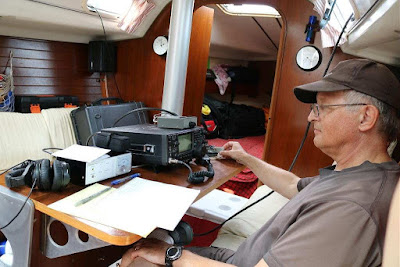 |
| Toby (VE7CNF) working the pileups! |
| Tuneup |
QSOs were made at anchor from Boho Bay (49 29.808N 124 13.857W near Lasqueti Is), Silva Bay (49 09.047N 123 41.670W near Gabriola Is), and Winter Cove (48 48.621N 123 11.575W near Saturna Is).
 |
| The route, heading north from Vancouver |
Stations worked on CW were VE7SL (Steve on Mayne Is, 12 to 48W TPO), VE7BDQ (John in Delta, 4 to 25W TPO), VE7VV (Roger in Victoria, 10W TPO), VE7CA (Markus in North Vancouver, 70W TPO), VA7JX (Jack in Campbell River, 100W TPO). Both VE7SL and VE7VV were also worked using LSB phone from Winter Cove.
Some of the contacts are shown below. Note the transceiver is not really on 160m ... it's just the i.f. for my 630m transverter!
Some of the contacts are shown below. Note the transceiver is not really on 160m ... it's just the i.f. for my 630m transverter!
I was impressed with the strength of ground wave signals given the low transmitter powers and EIRP's well below 5W. Received signals ranged from S1 to S9+10dB and copy was easy for all QSOs. QSO distances ranged from 10 to 142 km. We had low receive noise levels in all locations, with Silva Bay being a little noisier than the others due to many nearby boats and some shore power lines.
We tried disconnecting the gunnel ground wires and leaving only the keel, and found that the antenna capacitance and resistance did not change. When we disconnected the keel and left only the gunnel wires, the antenna capacitance dropped to about 87pF and antenna resistance dropped by a few ohms. It appears that the keel provided most of our ground coupling to sea water and it would have been a sufficient ground on its own.
It would have been interesting to compare signal reports with different ground arrangements. Next time...
More details of Toby's 630m transverter as well as a practical 630m antenna tune-up procedure can be found on his website here.
All-in-all, I think the 630m operation was a great success and very likely the first-ever 630m marine mobile operation on that band, as I don't recall this happening anywhere else over the years. It was also a great way to pay homage to the band's original maritime heritage where its quality groundwave and skywave capabilities were used to advantage for so many decades safeguarding mariners worldwide.
Maritime mobile operation on the amateur bands has some great history behind it, including the yacht YASME. In the mid-50's, Danny Weil was the first ever amateur to undertake DX'pedition style operations via sailboat, as he visited numerous rare islands in the Caribbean and South Pacific.
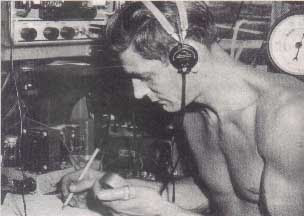 |
| Danny on the YASME - courtesy: www.gm3itn.co.uk |
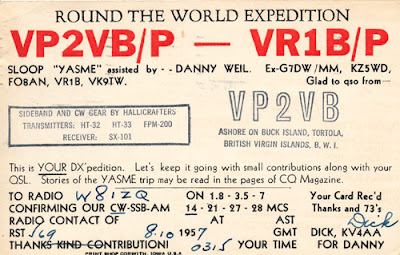 |
| Original YASME QSL - courtesy: http://hamgallery.com/ |
His exploits were regularly published in CQ magazine at the time and always made for exciting reading as Danny would eventually wreck three YASMES over the years! His adventures laid the groundwork for future island-hopping DX operations such as those undertaken by Gus Browning (W4BPD), Don Miller (W9WNV) and all that followed ... I'm sure they would all have enjoyed working the HAKUNA MATATA as well!
 A 630m Maritime Adventure
A 630m Maritime Adventure
| HAKUNA MATATA |
Crewed by Mark (VA7MM) and YL May (VA7MAY), Toby (VE7CNF) and XYL Nancy, the 31' Benateu recently completed a 14-day circumnavigation of Georgia Strait's Gulf Islands. This is a yearly adventure that has been successfully completed for the past few summers and looks as though it may now be an annual tradition.
Normally, the crew kept up regular radio contact on HF as well as on VHF when possible but this year saw a major departure.
In previous summers, near the end of the voyage, the crew has always visited us here on Mayne Island for an afternoon of vittles and libation before heading for home. There is always a good amount of time spent recalling the past-year's radio activities, winter projects and reminiscence of the 'good old days'. Last year, just as the party was ending, I jokingly suggested that 'next year', it would be cool to work them from the boat on 630m.
Although there was no immediate commitment, I knew that the seed had been planted, and with three of the four crew being engineers, I suspected it might be hard for them to resist, and ... just before departure, the local bunch of 630m ops were put on alert to be watching for CF7MM/mm on 475 kHz CW as they would be attempting to work us from three different overnight anchorages during their summer voyage!
Evidently Toby had been working quietly during the winter to make this become a reality. Here are some pictures of the system along with Toby's (the system's builder) comments.
| Variometer and matching transformer |
| Wire vertical and loading coil |
 |
| Toby (VE7CNF) working the pileups! |
| Tuneup |
QSOs were made at anchor from Boho Bay (49 29.808N 124 13.857W near Lasqueti Is), Silva Bay (49 09.047N 123 41.670W near Gabriola Is), and Winter Cove (48 48.621N 123 11.575W near Saturna Is).
 |
| The route, heading north from Vancouver |
Stations worked on CW were VE7SL (Steve on Mayne Is, 12 to 48W TPO), VE7BDQ (John in Delta, 4 to 25W TPO), VE7VV (Roger in Victoria, 10W TPO), VE7CA (Markus in North Vancouver, 70W TPO), VA7JX (Jack in Campbell River, 100W TPO). Both VE7SL and VE7VV were also worked using LSB phone from Winter Cove.
Some of the contacts are shown below. Note the transceiver is not really on 160m ... it's just the i.f. for my 630m transverter!
Some of the contacts are shown below. Note the transceiver is not really on 160m ... it's just the i.f. for my 630m transverter!
I was impressed with the strength of ground wave signals given the low transmitter powers and EIRP's well below 5W. Received signals ranged from S1 to S9+10dB and copy was easy for all QSOs. QSO distances ranged from 10 to 142 km. We had low receive noise levels in all locations, with Silva Bay being a little noisier than the others due to many nearby boats and some shore power lines.
We tried disconnecting the gunnel ground wires and leaving only the keel, and found that the antenna capacitance and resistance did not change. When we disconnected the keel and left only the gunnel wires, the antenna capacitance dropped to about 87pF and antenna resistance dropped by a few ohms. It appears that the keel provided most of our ground coupling to sea water and it would have been a sufficient ground on its own.
It would have been interesting to compare signal reports with different ground arrangements. Next time...
More details of Toby's 630m transverter as well as a practical 630m antenna tune-up procedure can be found on his website here.
All-in-all, I think the 630m operation was a great success and very likely the first-ever 630m marine mobile operation on that band, as I don't recall this happening anywhere else over the years. It was also a great way to pay homage to the band's original maritime heritage where its quality groundwave and skywave capabilities were used to advantage for so many decades safeguarding mariners worldwide.
Maritime mobile operation on the amateur bands has some great history behind it, including the yacht YASME. In the mid-50's, Danny Weil was the first ever amateur to undertake DX'pedition style operations via sailboat, as he visited numerous rare islands in the Caribbean and South Pacific.
 |
| Danny on the YASME - courtesy: www.gm3itn.co.uk |
 |
| Original YASME QSL - courtesy: http://hamgallery.com/ |
His exploits were regularly published in CQ magazine at the time and always made for exciting reading as Danny would eventually wreck three YASMES over the years! His adventures laid the groundwork for future island-hopping DX operations such as those undertaken by Gus Browning (W4BPD), Don Miller (W9WNV) and all that followed ... I'm sure they would all have enjoyed working the HAKUNA MATATA as well!
 The VK3BVW Winter DX Survey
The VK3BVW Winter DX Survey
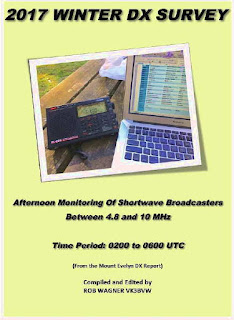 |
| courtesy: VK3BVW |
Every once in awhile I get the yen to tune through the international SW broadcast bands as my interest in good old, basic SWL'ing, is rekindled.
These bands are certainly quieter compared to when I first discovered the magic of radio and started DXing at age eleven using a lovely old all band cathedral-style GE set up in my attic-high radio shack ... no longer just a boring attic bedroom, but one with walls plastered with QSLs from all over the world.
 It was an amazing experience and one that obviously has left a lasting impression. There were hundreds and hundreds of stations on SW, throughout all of the HF bands but the highest I could tune was 19mc. on the old General Electric beauty ... who knows what was missed up higher as this was the peak of Cycle 19 and HF was on fire!
It was an amazing experience and one that obviously has left a lasting impression. There were hundreds and hundreds of stations on SW, throughout all of the HF bands but the highest I could tune was 19mc. on the old General Electric beauty ... who knows what was missed up higher as this was the peak of Cycle 19 and HF was on fire!As the huge decline in international SW broadcasting over the past few years continues, I'm always pleasantly surprised to see that there are still a lot of nice DX targets to hunt for.
I was particularly excited to read Rob's (VK3BVW) just released blogspot, describing his fall listening project from down-under. Being the DX season down in Australia, Rob decided to do daily bandscans of the low HF international SW bands (4.8 - 10MHz) to see what popped-up from day to day, which was actually afternoon to afternoon, since his listening was done between noon and 4PM local time. The project may be viewed here along with a nice introductory video ... in all, a huge effort by Rob with a lot of helpful details to go along with the logs.
While there be sure to visit the rest of Rob's SW blog ... there's a lot of good stuff here to get your SWL juices flowing!
His survey results are very encouraging for those of us that may have thought that there is just not much to be heard when it comes to international SW broadcasting. As Rob points out, even though these logs reflect what was heard in Australia, most, if not all should be hearable in North America as well, even more so as we approach the DX season in North America.
So pull up your chair sometime after dark, grab a cup of your favorite beverage, and take a relaxing tune through the SW bands with Rob's list in hand ... see what you can find, and perhaps rekindle that early fascination in SW radio outside of the ham bands that may have hooked you many years ago. You may also find this broadcast frequency database helpful should you run across something unknown.
 The VK3BVW Winter DX Survey
The VK3BVW Winter DX Survey
 |
| courtesy: VK3BVW |
Every once in awhile I get the yen to tune through the international SW broadcast bands as my interest in good old, basic SWL'ing, is rekindled.
These bands are certainly quieter compared to when I first discovered the magic of radio and started DXing at age eleven using a lovely old all band cathedral-style GE set up in my attic-high radio shack ... no longer just a boring attic bedroom, but one with walls plastered with QSLs from all over the world.
 It was an amazing experience and one that obviously has left a lasting impression. There were hundreds and hundreds of stations on SW, throughout all of the HF bands but the highest I could tune was 19mc. on the old General Electric beauty ... who knows what was missed up higher as this was the peak of Cycle 19 and HF was on fire!
It was an amazing experience and one that obviously has left a lasting impression. There were hundreds and hundreds of stations on SW, throughout all of the HF bands but the highest I could tune was 19mc. on the old General Electric beauty ... who knows what was missed up higher as this was the peak of Cycle 19 and HF was on fire!As the huge decline in international SW broadcasting over the past few years continues, I'm always pleasantly surprised to see that there are still a lot of nice DX targets to hunt for.
I was particularly excited to read Rob's (VK3BVW) just released blogspot, describing his fall listening project from down-under. Being the DX season down in Australia, Rob decided to do daily bandscans of the low HF international SW bands (4.8 - 10MHz) to see what popped-up from day to day, which was actually afternoon to afternoon, since his listening was done between noon and 4PM local time. The project may be viewed here along with a nice introductory video ... in all, a huge effort by Rob with a lot of helpful details to go along with the logs.
While there be sure to visit the rest of Rob's SW blog ... there's a lot of good stuff here to get your SWL juices flowing!
His survey results are very encouraging for those of us that may have thought that there is just not much to be heard when it comes to international SW broadcasting. As Rob points out, even though these logs reflect what was heard in Australia, most, if not all should be hearable in North America as well, even more so as we approach the DX season in North America.
So pull up your chair sometime after dark, grab a cup of your favorite beverage, and take a relaxing tune through the SW bands with Rob's list in hand ... see what you can find, and perhaps rekindle that early fascination in SW radio outside of the ham bands that may have hooked you many years ago. You may also find this broadcast frequency database helpful should you run across something unknown.
